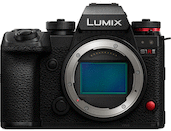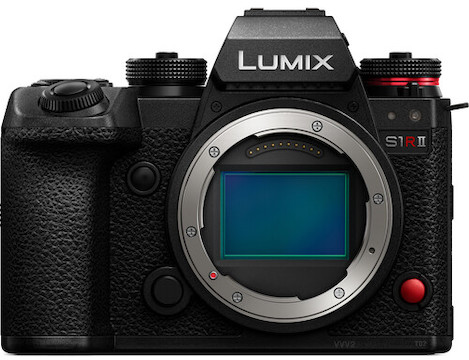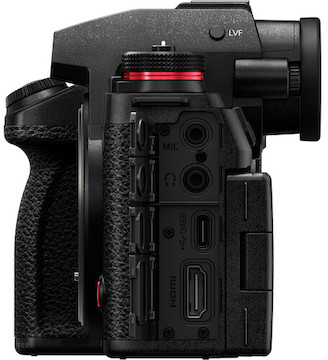The Panasonic DC-S1R II is a high-resolution, full-frame, L-mount hybrid camera aimed at pro photographers who need advanced video options. It is the update of the popular DC-S1R. Key features include:
- 6.4K open gate, 8K30p and 4K120p 10-bit recording
- 8-stop, 5-axis IBIS and cropless Active IS
- 40 frames per second, 80-102,400 ISO
- 25% lighter and about 3% smaller than S1R
Lumix’s First 8K Hybrid Camera. This flagship camera represents the Lumix line’s entry into 8K video, in addition to open gate 6.4K and 4K120p. Other headline advancements include internal ProRes RAW recording, 14 stops of dynamic range, 40 fps burst shooting, and 177 megapixel image capture in sensor-shift High Resolution mode. This is truly a something-for-everyone camera.
What’s Changed? The S1RII is smaller and lighter than the DC-S1R and offers unlimited raw video, a higher max ISO, much faster burst shooting, a boost in stabilization, and increased battery life (doubled when paired with the DMW-BG2 Battery Grip). Flash photographers will love the return of a flash sync port. There have also been big improvements made to subject detection, with much more accurate tracking of eyes and faces even when objects get in the way. The in-body image stabilization is now “cropless”, so you’ll have a wider viewing angle when using IBIS. Lastly, a new Photo Style, Cinelike A2, has been added to the range of color expressions.
There are a couple of minor setbacks with this new model. The sensor is a bit smaller, with a 6% reduction compared to the original S1R (which also means the high-resolution mode is slightly smaller at 177 megapixels compared to 187). However, the 44MP BSI CMOS sensor reads out much more quickly than the earlier model to meet the demands of 8K recording and 40 fps burst capture. The LCD screen is also slightly smaller but, unlike in the S1R, this one is fully-articulating.
Expanded Workflow. Panasonic has beefed up their connectivity with a new (at the time of this writing) LUMIX Flow app for monitoring and organizing scenes with your smart device. The LUMIX Lab allows you to shoot with your smartphone, download creator LUTs, and stream up to 4K30p. The S1RII is now also tether-compatible with Capture One and you can dump footage directly to an SSD over USB-C. It has a built-in streaming encoder so you won’t need any extra hardware to stream with this camera. If you don’t have access to WiFi you can tether off your smartphone via USB-C. Direct IP streaming over Ethernet is possible with an adapter. When paired with the DMW-XLR2, 32-bit float audio recording is unlocked.
Build Quality and Ergo Updates. The S1RII body borrows heavily from the S5II but with a new 3-way selector to choose between photo, video, and S&Q (slow and quick settings). Input your preferred settings for each one for fast switch-ups. Dual record buttons can be programmed as something else when in photo mode and front and back tally lights make recording confirmation very clear. A locking feature will prevent controls you choose from being adjustable mid-shoot, adding a layer of security to your workflow. The shutter mechanism has a protective curtain to keep dust away from the sensor when changing lenses. While most of the L-mount Lumix cameras have dual SD card slots, this one is equipped with one SD slot and one CFexpress Type B slot for recording internal raw video (and for faster writing performance overall). Lastly, the sealed buttons and magnesium alloy shell ensure weatherproofing. The S1RII is an excellent hybrid powerhouse for indie filmmaking, pro and consumer photography, documentary work, and B-cam footage.

























